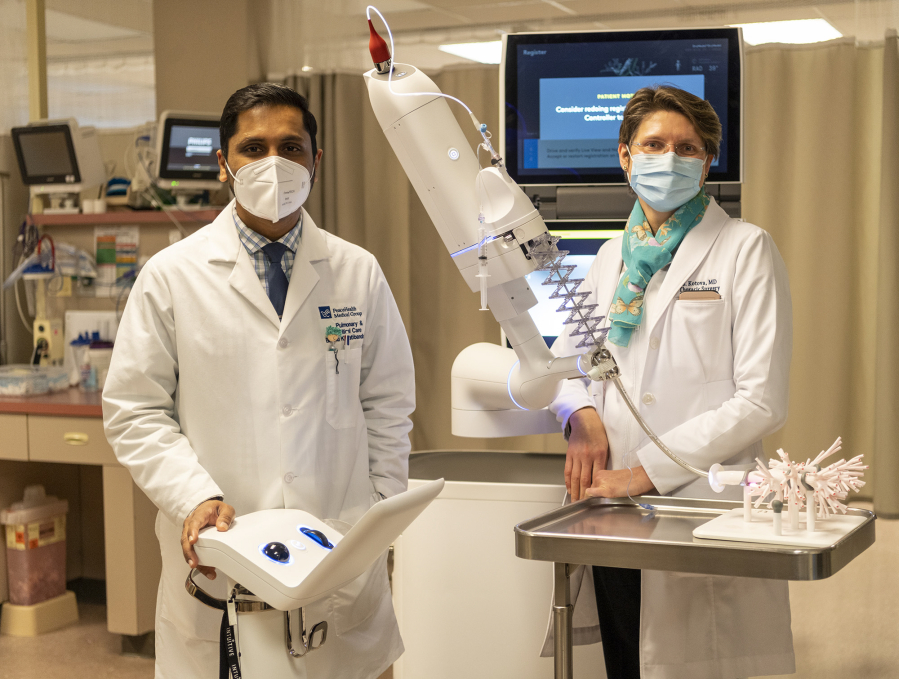Portland resident Robin Hungerford felt as if the air was being sucked out of the room when she learned she might have lung cancer. Having smoked for 51 years, she was not surprised that her CT scan showed a mass on her lung, but she was terrified.
“I was so scared,” the 67-year-old retired preschool teacher said. “I didn’t think I was healthy enough for surgery.”
It turned out she was healthy enough for surgery, though she did not undergo a traditional operation. Thanks to a new procedure pioneered by two surgeons at PeaceHealth Southwest Medical Center in Vancouver, she had a lung biopsy and the mass removed in one operation, receiving a diagnosis and treatment at the same time.
Normally, when a patient is diagnosed with a nodule or mass on their lung, they are referred to a pulmonologist, who performs a lung biopsy — a procedure that occasionally requires anesthesia — to confirm whether it is cancerous.
If the nodule or mass is cancerous, the patient is referred to a thoracic surgeon, who determines if it can be surgically removed. If that’s possible, the patient undergoes another procedure that requires another round of anesthesia. The patient is then referred to other specialists to see if chemotherapy or other treatment is needed.
On average, patients wait three months from the time a nodule or mass is first discovered to when they receive a diagnosis and treatment.
The wait between a biopsy and a diagnosis can be emotionally difficult for patients, and Hungerford is grateful she didn’t have to wait. She had the procedure done at PeaceHealth in December, making her the first patient in the Northwest to receive the innovative dual operation.
“I like the idea of one surgery instead of two,” she said. “Why take the risk of being knocked out twice, two hospital stays and all of that?”
Now, three months later, Hungerford is cancer- and smoke-free following a smooth convalescence.
At first, she didn’t know that she had undergone a novel procedure.
“I was happy to learn that I’m a milestone, a medical milestone,” she said. “I got to participate in the advancement of science. It was good for me. And now I’m still here.”
Developing the procedure
Pulmonologist Bhanu Patibandla and thoracic surgeon Svetlana Kotova are behind the inventive collaboration.
They are the only surgeons performing the dual operation in the Northwest, and PeaceHealth is one of only a few medical centers in the nation offering the procedure to eligible patients.
Patibandla, who joined PeaceHealth in 2018, said the operation grew out of a robotics program he helped launch in 2021.
“At PeaceHealth, we are striving to optimize every step in the lung cancer care continuum to reduce the delays in diagnosis and treatment,” he said. “Our outcomes with this program have been exceptional.”
As part of the program, Patibandla collaborated with Kotova — a thoracic surgeon trained in robotics who joined PeaceHealth last year — and other specialists to develop the dual operation using robotic technology.
Using a machine called the Ion Endoluminal System, which PeaceHealth acquired last year, the surgeons can locate, biopsy and remove lung nodules that are less than a centimeter in size, a tenth of what could be biopsied and removed traditionally, Kotova said.
“We figured that this would allow us to offer diagnosis and treatment in the same day rather than the traditional approach of performing biopsies first for diagnosis and then scheduling surgery later,” Patibandla said. “With this new workflow, when we see a patient with a potential early-stage cancer based on their scans, we plan for a combined approach.”
The procedure can only be performed on people with early-stage lung cancer who meet specific criteria. It requires general anesthesia and takes three to four hours to complete. Patients spend one to two days recovering in the hospital following the operation.
How it works
First, Patibandla performs a robotic-assisted biopsy using the Ion Endoluminal System. The machine creates a 3D map of a patient’s lungs using a CT scan and then traces the safest and most efficient route through the lung to the site of the nodule or mass.
“It’s very similar to navigation technology in your car,” Patibandla said. “If you want to go somewhere, you put in the address and drive based on the navigation guidance, right? Similarly, we want to go to a spot on the lung where we want to biopsy, and we use the 3D map and create a roadway to that.”
Once the route is determined, Patibandla guides a microscopic light, camera and scraper through the lung using a track wheel and scroll ball to the site of the nodule or mass, where he then marks its location and takes a biopsy. The machine allows Patibandla to go deeper into the lung than would be possible in a traditional lung biopsy.
As Patibandla collects a biopsy, lymph nodes in the chest are evaluated using ultrasound. If cancer is found in the lymph nodes, then the lung cancer is considered advanced, meaning the dual procedure cannot be performed. If cancer is not found in the lymph nodes, however, then the nodule or mass can be surgically removed.
After the biopsy is completed, the samples are analyzed in the operating room while the patient remains under anesthesia. If the nodule or mass is confirmed as cancerous, Kotova surgically removes it, completing the operation.
“Now, instead of waiting for weeks, and sometimes months, to know what patients have and to receive treatment, all of this can be done in a matter of hours,” Patibandla said. “That’s a huge advantage for the patients, but also for the physicians and others involved in the patient’s care.”
Impact and looking forward
Patibandla and Kotova have completed the operation on five patients, and another is scheduled for Thursday.
Both said that the collaboration allows them to treat additional patients with greater efficiency.
In the past, if a nodule was located on the lung but was too small to biopsy, a patient would have to wait to see if it grew before receiving a biopsy and treatment. Now, “there is less of a waiting time and more intervening in changing the course of a lung cancer,” Patibandla said.
Additionally, before developing this operation, roughly 50 percent of patients had to receive two biopsies — two separate procedures — for a diagnosis, something the dual procedure will eliminate for many patients, Patibandla said.
Patibandla and Kotova said the operation has the potential to become more popular but cautioned that it will take time to further develop it before it becomes more widely available and affordable. For now, PeaceHealth’s Lung Nodule and Thoracic Oncology program will become a mentor site for training other physicians in robotic bronchoscopy across the nation, Patibandla said.
“Robotic surgery is being more rapidly assimilated throughout not just our community, but throughout the country,” Kotova said.
Patibandla and Kotova emphasized the importance of collaboration in developing the procedure.
“We are fortunate at PeaceHealth to have a team of people who are always excited to integrate their expertise with other specialties and open to new ideas,” Patibandla said. “When we get a patient that potentially has lung cancer, that particular case is evaluated by all of the team members, even if the patient is not being physically seen by all of them. That’s a great advantage for patients at these kinds of centers.”
Importance of screenings
Lung cancer is the leading cause of cancer deaths globally and in the United States. It kills more people every year than breast, prostate and colon cancers combined. Because of the COVID-19 pandemic, many people delayed getting routine cancer screenings, and some medical centers are concerned about a wave of incoming late-stage cancer diagnoses.
The most effective method for treating cancer is to catch it early and to begin treatment as soon as possible.
“Get back into your usual screenings,” Kotova said. “If you have problems or symptoms that you’ve been putting off, go back to your doctor and talk to them about your problems. Don’t delay.”
To learn more about PeaceHealth’s Lung Nodule and Thoracic Oncology program, visit www.peacehealth.org/southwest/regional-cancer-center/our-services/lung-nodule-program.




